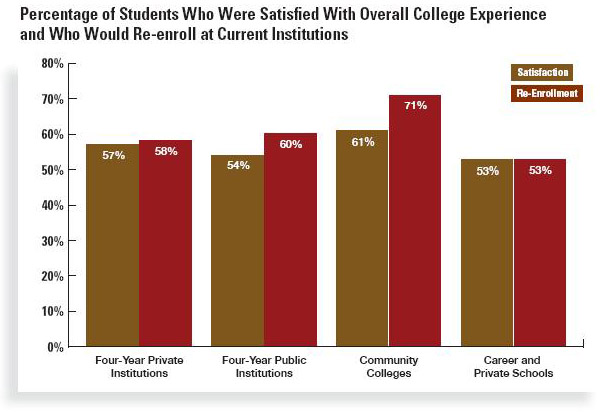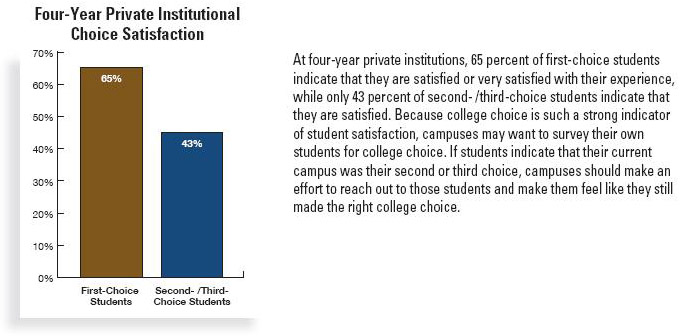student success
Community colleges lead the way in overall student satisfaction
The 2011 National Student Satisfaction and Priorities Report reveals the satisfaction scores for more than 804,000 traditional undergraduate students from 1,130 four-year and two-year institutions, both public and private. (The data are taken from the Noel-Levitz Student Satisfaction Inventory™.) This chart shows the percentage of students who indicated that they are satisfied or very satisfied with their college experience and the percentage of students who responded that they would probably or definitely re-enroll if they had it to do over again:

As we have seen in recent years, community colleges continue to lead the way with satisfied students and with students who feel that they made the right decision to enroll at their two-year public institution, while career and private schools have the lowest overall responses in both categories.
This year’s executive summary examines the perceptions of subpopulations within the four-year private institutions. (The 2010 Executive Summary focused on community college results). One of the most fascinating findings is how much overall satisfaction drops from students who say they are at their first-choice institution (63 percent of students) as compared with students who say they are at their second- or third-choice institution (47 percent of the data set).

While it is not that surprising that students who are where they want to be are more satisfied, it is interesting to see how much more satisfied they are than students who wanted to attend a different institution than the one at which they enrolled (65 percent vs. 43 percent). These data give enrollment managers opportunities to consider how they are creating perceptions of being a first-choice institution for the students they are recruiting.
The appendices of the 2011 report examine specific results for each institution type, including strengths and challenges on a national level, scales/categories in order of importance, and factors in the decision to enroll. I encourage you to take a look at the results specific to your institution type.
While it is important to monitor national satisfaction trends for a broader perspective, the most important data you can have on your campus are the satisfaction and priority scores for your own students. Effective institutions survey their constituencies regularly, compare their data to past performance and then actively respond to challenges.
What is the assessment plan for your campus? Feel free to share your thoughts in the comments, or contact me via e-mail.
This is the second in a series of blog entries on the 2011 National Satisfaction and Priorities Reports now available from Noel-Levitz. Read my previous post on the satisfaction and priorities of online learners.
